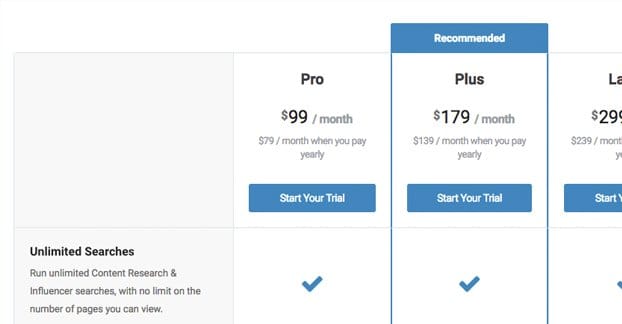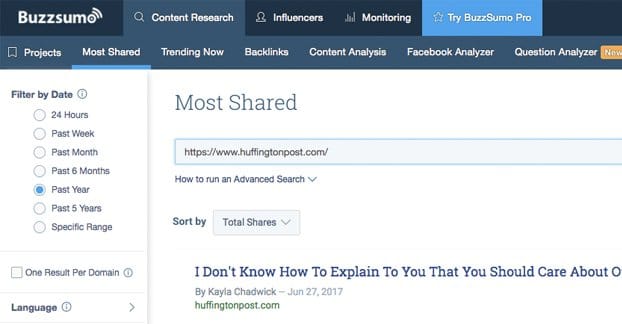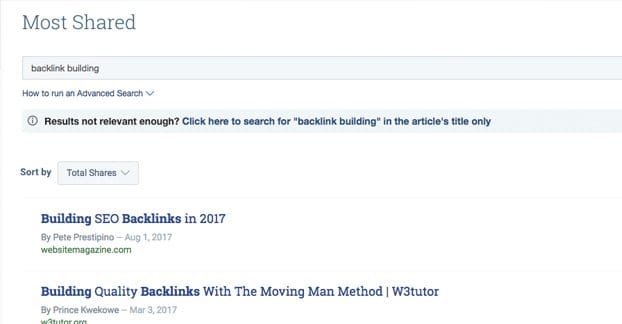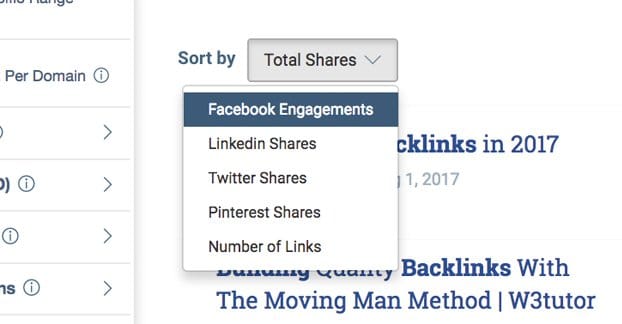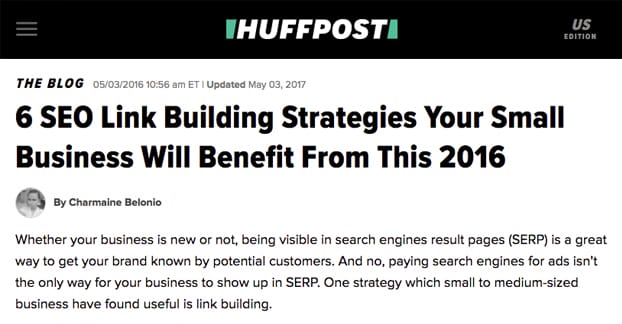BuzzSumo is one of many tools on the web designed to help you with your marketing. In this case, it’s specifically a tool that analyzes posts by recording their social shares, along with a bunch of deeper detail for paying members.
Since the tool can be pretty expensive, I’m going to focus on how you can use it on an individual basis to enhance your chances of getting guest posts accepted on your target sites.
How expensive do I mean? The cheapest available version of the pro plan is $79 per month and is still rather limited in what it can do. To unlock most every feature you could want at a sub-agency level, you’re looking at spending $239 per month.
You know what’s better than 80 or 240 bucks a month? Free! BuzzSumo has a free version of the tool available as a sort of demo; you can use it and get useful information, they just have the full dashboard visible but not usable. If you click on part of the dashboard that’s restricted, they will simply prompt you to upgrade your account.
Let’s see how you can use what you can for free to help make guest posting easier and more effective.
Step 1: Pick a Target Site
The first thing you need to do is pick a target website. A lot of the work we’re doing will be customized for your target site, so having one specific site in mind is crucial.
I’ve written about the different categories of sites before. Today, I’m aiming at medium-quality sites. The true high quality sites aren’t necessarily going to be swayed by data and the perspective you use with the information we’re harvesting. In fact, they tend to rely more on networking and an insider connections, so we’re putting them on the sideline.
On the opposite end of the spectrum, the low-end sites aren’t suitable for this project. They might not have many or any social shares on their content, so there’s no way to easily tell which posts are the best based on BuzzSumo data. Oh, they’ll be sorted based on the data that does exist, but the scale is too small for it to matter. The difference between a post with three shares and a post with five is minimal.
The sites we’re targeting are sites that are reasonable quality but aren’t too high in the ranks and full of themselves. The ones that are mostly open to guest posts, without requiring excess effort. They’re popular enough that they likely get quite a few pitches, but not so popular that they just ignore most of them. When they read all of the pitches, and when they’re aware of their own content strategy, they can recognize when you’ve done the legwork to figure out the most relevant and acceptable content.
Of course, you have to remember that the quality level of a site is relative to your own. If you’re running a site in the upper echelons of your industry – like Search Engine Journal or Kissmetrics – you won’t find it difficult to guest post on other top-tier sites. There are, thus, very few sites that are actually too high to reach.
Conversely, if you’re running a virtually brand new site, even reaching the mid-range sites can seem an impossible task. It’s easier to approach the other small-time sites and attempt to network with each other, to mutually benefit each other until you’ve grown enough to be recognized.
If you want, you can make up a list of potential sites and run them all through BuzzSumo in step four. You’ll be repeating this process with each site and topic, after all. If you want to pay for a month of the service, you can then run all of your sites through and cancel before you’re charged for a second month.
Optional: use BuzzSumo to go looking for target sites. One of the pro-level features of BuzzSumo is the ability to plug in topic keywords and get a list of the most influential users in that niche, based on social shares and followers. You want to use more general keywords for this. The only reason I list this as option is because it’s one of the paid features, and I’m focusing on using the tool as it is in it’s free state. The advanced influencer search is only available in the Large or Enterprise plans, not the Pro or Plus plans, so it’s not available even with the free trial.
Step 2: Pick a Target Topic
Picking a topic is going to be somewhat general at this stage. Just think of where the intersection between your site and the target site is, content-wise. For example, if I’m running a site about marketing through off-site techniques like guest posting, and the target site is primarily focused on onsite techniques like optimization, meta data, and content production, I can write something focused on how publishing guest posts is beneficial to the host site.
Your topic should be relatively broad. The reason for this is because you’re going to come up with a handful of keywords related to the topic, ideally long tail keywords, which you can use in the BuzzSumo tool to gain inspiration. BuzzSumo allows both URLs and keywords and will analyze content for both.
Feel free to come up with a large list of relevant keywords for general research purposes as well. When you plug in a keyword and see the best content in that niche, that can give you inspiration both for guest posts and for your own blog. The only reason I’m focusing on guest post keywords specifically is that they might not be keywords you want to cover normally.
Like in the example above, if you’re writing on a site that covers a facet of your industry that you don’t normally cover, it pays to do some research. You don’t necessarily know what the content landscape looks like in a niche you don’t cover, but you need to know if you want to write a successful guest post.
Step 3: Research the Target Topic
Once you have your keyword list, it’s time to start actually using BuzzSumo. One thing to note before we start: you will probably need to register for a free account. They have a version you can use without logging in or registering to anything, but it has a limit on searches you an perform. That limit resets, but I’m not sure if it’s a weekly or monthly period. Better to simply register.
In fact, if you’re prepared to do all of this research right away, you should register. Registration gives you the pro-tier plan, which is the $80/month plan, for free for 14 days. You don’t even have to plug in financial information for auto-enrollment; they don’t ask for payment information until your free trial has ended. All you need to register for the free trial is your name, email address, phone number, and password. They use phone for verification if email verification fails. The only downside is the same as with any other free trial service; your email will be the target of a drip campaign for onboarding or sales until they’re you’re not coming back, or they’ve gotten you to pay.
Anyways, what you want to do here is start running your keywords into the tool. The primary search results you get will be a list of the top content relating to that keyword, in the last six months, as sorted by total social shares. You can change search parameters, but I would recommend holding off. The defaults are good enough for up to date content ideas, so only expand or narrow the timing if your keywords all seem to bring up the same handful of content.
Now things get a little tricky and personal. You need to look over the list of top content and figure out how you can create something of similar quality. You’re looking for ideas for your own posts, topics you can cover, holes in the coverage where you can find a niche, and opportunities to out-do an existing high-quality post. I can’t help you specifically; you need to bring your expertise to bear.
Step 4: Research the Target Site
Now it’s time to plug in the URL of the target site. You want to use the main domain for their site, the www.example.com, not a subdomain or a specific blog post URL. What you’ll get is a listing of all of the posts on that site, or at least the ones in your specified time frame, ordered by their social shares.
In this case, I recommend changing it so you see everything published in the last year. Data older than a year isn’t necessarily that valuable, but the most recent year will show you the current direction of the site’s content strategy.
This is where the results of the previous step come into play. What you’re doing is looking for places where the ideas you generated from the topic research coincide with top-performing content on the target site. Some ideas will already be covered, and that means you should set them aside. The idea might still be good for your own site or for a guest post on another site, but it won’t be useful for this target site. Who wants someone writing a guest post on a topic they’ve already covered in detail and is performing well?
Again, this is something you’re going to have to handle yourself. I can’t tell you which gaps are good and which simply have failed posts in them. Ideally, you want something that builds upon the content that the site already posts. If they have a great guide on link building that is a little weak in one area, you try to cover that one area in more detail. Maybe they have a series of posts on a subject that missed the topic you prefer to cover, so it lends itself well to your expertise. There are a lot of potential opportunities.
Step 5: Create the Winning Pitch
At this point, it’s time to bring it all together. You have plenty of ideas; now you just need to put them into a format that will help get them accepted. BuzzSumo won’t help you with this part, unfortunately.
One major question I’ve been asked recently – and might cover in more detail in a future post – is whether you should pitch a single post or several ideas. Both methods have their proponents. For example, this site recommends giving two or three options to the editor, so they can pick the one that fits the site the best. On the other hand, this site recommends a laser-focus on a single post, complete with outline already available.
I like the multi-idea option primarily because it increases the chances of success while minimizing the work involved. When you have three ideas, the target site might decide they don’t like any of them, but you still had three chances when the other guest poster only had one. You have an increased chance of getting one of the ideas through, and there’s always the chance that the editor decides they like two or even all three of the ideas, and asks you to run with them all.
On the other hand, with the outline and focus of a single pitch, you have more material to convince the editor that they should accept your guest post. You don’t just leave them a title or a topic and their imagination. You bring the entire concept to the table.
In this case, it’s up to you which you pick, and it depends on how many viable options you came up with during the previous steps. Write up your pitch and send it on its way.
 ContentPowered.com
ContentPowered.com

